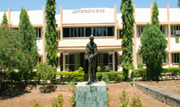Gandhigram had its genesis on 7th October, 1947 and it progressed and expanded remarkably in the areas of rural community development under the dynamic leadership of its founders, Dr.G.Ramachandran and Dr.T.S.Soundaram Ramachandran, the dedicated disciples of Gandhiji. Drawing huge inspirations from the works and ideas of Mahatma Gandhi, they worked with enormous amount of zeal and commitment for the betterment of the rural people in the vicinity and it was their unstinted dedication and committed faith in the Gandhian ideals that has made Gandhigram what it is today.
The Gandhigram Rural Institute of Higher Education was started in 1956 to bring higher education closer to the villagers. The significant educational experiment, broadly conforming to the recommendations of the Dr.R.Radhakrishnan Commission relating to rural universities and rural colleges, was inaugurated by Dr.R.Rajendra Prasad, the then President of India on August 1956. The first academic block of Gandhigram Rural Institute was opened by the former Prime Minister of India, Jawaharlal Nehru on December, 1957. Right from its inception, the institute is fully funded by the Government of India (the then Ministry of Human Resource Development and now Ministry of Education).
Salient Features
-
Dr.G.Ramachandran and Dr.T.S.Soundaram Ramachandran are the founders of Gandhigram Rural Institute (GRI). They were devoted disciples of Mahatma Gandhi and were involved actively in the freedom movement. Their marriage was solemnized in the Sabarmathi Ashram by Gandhiji in the year 1940.
-
Under the advice of Gandhiji, the couple chose a place near Chinnalapatti village, Dindigul District (45 km from Madurai) for establishing an institution for education, health and sanitation and village industries.
-
The place fondly named ‘Gandhigram’ was inaugurated by the Father of our Nation, Mahatma Gandhi on 7th October 1947 with a powerful message “Success Attends where Truth Reigns”. Since then, Gandhigram has been a hub of community development.
-
Gandhigram village received national attention for an important reason. On February 2, 1946, the local people had a dharshan of Gandhiji while he was traveling from Madurai to Palani by train. He spoke to the eagerly waiting people for a few minutes.
-
The Institute is situated on a serene and verdant campus environment spreading over about 207 acres of land, and most of these lands were donated by the villagers voluntarily with the hope that their children would get education and employment.
-
In the year 1956, eleven rural institutes were established by the Ministry of Education, Government of India and GRI was one among them. The Central Government was providing funds to the institute from the year 1956. While most of the rural institutes were closed due to various reasons, the Gandhigram Rural Institute remains alive and vibrant, rendering yeoman service to students and village communities.
-
The Gandhigram Rural Institute has been getting constant support of Central Government because of the Institue's vibrant ability to reinvent itself to face challenges of changing-times. This has enabled the Institute to grow and achieve laudable results. It has been fostering innovations in extension and rural development activites and as a result. It has been credited with praiseworthy best practices.
-
The most important educational experiment of Gandhigram is the system of education envisaged by Gandhiji in the form of ‘Nai Talim’ which is founded on the ideal that providing basic education to the rural people is a basic requirement for rural development.
-
The Institute strongly believes in the words of Mahatma Gandhi – “The end of all education should be service and if a student gets an opportunity to render service while he/she is studying, he/she should consider it as a rare opportunity and treat it not as a suspension of his/her education but rather its complement”.
-
The Institute has grown by leaps and bounds and it was conferred the status of Deemed to be University in 1976 by the then Ministry of Social Welfare and Education (now Ministry of Education). It was registered under Societies Registration Act of 1860.
- Honourable Presidents of India Shri Venkatraman, Shri Abdul Kalam, Honourable Vice-President of India Shri Hamid Ansari, Honorable Prime Ministers of India Shri Narendra Damodardas Modi, Shri Pundit Jawaharlal Nehru, Smt. Indira Gandhi, Chief Ministers of Tamil Nadu Shri M.K.Stalin, Shri C.Subramaniam, Shri K.Kamaraj and many noted freedom fighters, national leaders and international figures including Khan Afar Khan, Martin Luther King Jr., Morarji Desai have visited the Institute at different points of time.
The Chancellors and Vice-Chancellors are appointed by Government of India. The former Vice Presidents of India were the Chancellors of the University till 2012. The Government appointed Ms.Renana Jhabvala, Chairperson of SEWA Bharat (Self Employed Women’s Association) as Chancellor for a term of 5 years from 30th March 2012 to 29th March 2017. Dr. KM. Annamalai, a renowned Physiotherapist and Social Activist has been appointed as Chancellor by the Government from 20th April 2017.
The Institute has been consistently getting ‘A’ Grade by NAAC right from the very first cycle (2005) of accreditation to the third cycle (starting 2016). The Ministry of Education has also placed the Institute under A-Category University on the basis of the recommendation of Tandon Committee.

